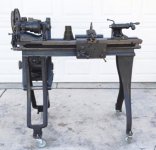Hello
New member here. I would like to contribute by introducing my newly acquired BF Barnes lathe. I suspect this is a lathe was possibly made right after Benjamin separated from WF Barnes and stuck out on his own. The change gear plate clearly indicates BFB in Rockford. The right side legs are cast with “B. F. Barnes Co. Rockford, ILL.” Any additional info is certainly welcome.
This BFB lathe sat idle in our families hardware store since the 40’s. The store was in a small central Illinois town which was far from wealthy. Heck, the hardware store sold heating coal up till the late 60’s! Money was always scarce so my grandfather bartered a lot. He ending up with this Barnes in addition some other interesting machinery including a larger South Bend lathe of similar vintage. No family members ever recall using them.
I am not terribly familiar with the screw feed lathes. The only lathe I use (semi-frequently) is a Derbyshire WW lathe which can fit into a bread box. I would like to get this BFB lathe back into running condition. The concept of a screw feed carriage intrigues me. No plans for heavy use, just tinkering. The lathe is definitely well used, some gouges in the ways. Grease fittings on the spindle bearing caps so the spindle and bearing are a bit scored. Some of the gears have broken teeth which have been brazed and re-profiled. I think the lathe was last painted using a mop and a combination of soot and linseed oil. Lots of character. Can’t get the feed clutch to work so that will have to come apart. Also some problems with the bull gear pin - I see no way to pull it out to disengage. But these are most likely simple as I see nothing mechanically complicated on this machine (nice!).
So todays questions:
Did BFB Co. use model numbers? If so any idea of the model of this example?
Change Gears. There are 11 change gears with two duplicates. The change gears are 14DP (!), 7/16” thick with 1/8” keyed 9/16” dia bore. I suspect they share dimensions with some of the WF Barnes lathes, What models? (So I can start looking)
Spindle thread size the outside diameter of the spindle thread measures 1.09” and the tpi is definitely 8. So, do I look for a 1x8 chuck, faceplate, etc…? I sure hope it is not an odd thread profile, any history on what any of the Barnes used in regards to spindle threads.
Motor size. There is a period appropriate Wagner Electric 1/3 hp motor. The wires are cloth and have not aged well. Since I will be sourcing a new motor should I replace with 1/3 hp or, given nameplate rating optimism of today, should I consider ½ hp?
New member here. I would like to contribute by introducing my newly acquired BF Barnes lathe. I suspect this is a lathe was possibly made right after Benjamin separated from WF Barnes and stuck out on his own. The change gear plate clearly indicates BFB in Rockford. The right side legs are cast with “B. F. Barnes Co. Rockford, ILL.” Any additional info is certainly welcome.
This BFB lathe sat idle in our families hardware store since the 40’s. The store was in a small central Illinois town which was far from wealthy. Heck, the hardware store sold heating coal up till the late 60’s! Money was always scarce so my grandfather bartered a lot. He ending up with this Barnes in addition some other interesting machinery including a larger South Bend lathe of similar vintage. No family members ever recall using them.
I am not terribly familiar with the screw feed lathes. The only lathe I use (semi-frequently) is a Derbyshire WW lathe which can fit into a bread box. I would like to get this BFB lathe back into running condition. The concept of a screw feed carriage intrigues me. No plans for heavy use, just tinkering. The lathe is definitely well used, some gouges in the ways. Grease fittings on the spindle bearing caps so the spindle and bearing are a bit scored. Some of the gears have broken teeth which have been brazed and re-profiled. I think the lathe was last painted using a mop and a combination of soot and linseed oil. Lots of character. Can’t get the feed clutch to work so that will have to come apart. Also some problems with the bull gear pin - I see no way to pull it out to disengage. But these are most likely simple as I see nothing mechanically complicated on this machine (nice!).
So todays questions:
Did BFB Co. use model numbers? If so any idea of the model of this example?
Change Gears. There are 11 change gears with two duplicates. The change gears are 14DP (!), 7/16” thick with 1/8” keyed 9/16” dia bore. I suspect they share dimensions with some of the WF Barnes lathes, What models? (So I can start looking)
Spindle thread size the outside diameter of the spindle thread measures 1.09” and the tpi is definitely 8. So, do I look for a 1x8 chuck, faceplate, etc…? I sure hope it is not an odd thread profile, any history on what any of the Barnes used in regards to spindle threads.
Motor size. There is a period appropriate Wagner Electric 1/3 hp motor. The wires are cloth and have not aged well. Since I will be sourcing a new motor should I replace with 1/3 hp or, given nameplate rating optimism of today, should I consider ½ hp?






